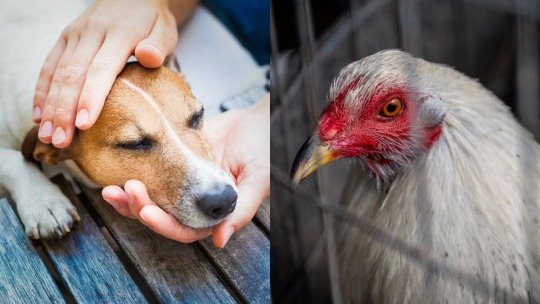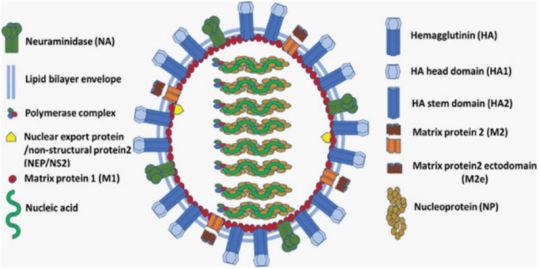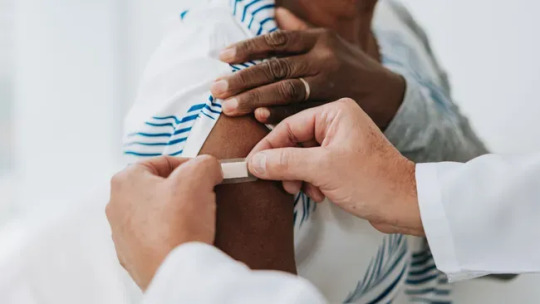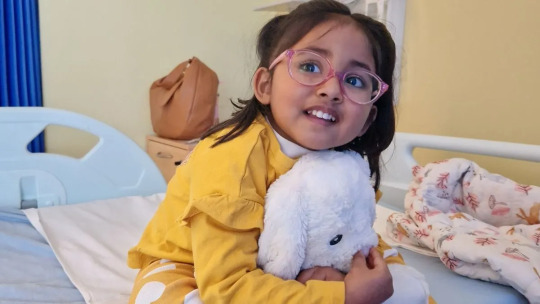#human influenza
Text
Cows have entry portals for both human and bird flus. This new finding may mean that cattle could host both types of flus at once. The two viruses could then swap parts to create a new type of influenza, maybe even one that could cause a pandemic.
Cattle have three types of influenza A receptors — entry portals viruses use to infect host cells — veterinarian Charlotte Kristensen and colleagues report May 3 at bioRxiv.org. One portal is like a receptor that decorates human cells. Another is like that found in chickens. And the third resembles receptors from ducks.
One of those avian receptors may have allowed a virus from a wild bird to infect a dairy cow in Texas, leading to the current H5N1 bird flu outbreak in cattle.
Researchers have long thought cattle were resistant to influenza A, says Kristensen, of the University of Copenhagen. Some cows have been infected in lab studies, and there have been suggestions that cows might sometimes catch human seasonal influenza. But it surprised many experts when H5N1 bird flu was found in dairy cattle and in grocery store milk this spring (SN: 4/25/24).
continue reading
22 notes
·
View notes
Text
the body: *gets a cold*
Cassian, the world's biggest drama queen: oh no! I fear I have caught the plague and I shall perish soon! don't forget me when I pass; I won't forget you! oh, it is the end indeed!
#i’m sick#sick#influenza#did#did osdd#did alter#system things#did memes#dissociative identity disorder#did stuff#actually did#osddid#dissociative system#non human alter#system alters#system stuff#system dynamics#systems#system
13 notes
·
View notes
Text



"If a pig catches both a human influenza A virus and an avian influenza A virus at the same time, it can spark a process known as viral reassortment — a genetic exchange in which flu viruses swap gene segments."
"Those swaps can introduce dramatic changes, producing a new virus with certain properties of a non-human strain coupled with the capacity to infect and spread between people."
"The death rate in humans may be upwards of 50 per cent, World Health Organization data suggests, though it's possible that milder infections are getting missed, skewing the case fatality ratio. Still, in a population that's never been exposed, the global impacts could be dire."
"More human cases could also be happening under the radar among farm workers who've moved to the U.S. from abroad, don't speak English as their first language, and may be hesitant to seek medical help, he added."
"So I think there's probably underreporting on both sides," Armstrong said."
"If [H5N1] gets into a population where there's constantly animals going in and out … it might not ever leave."
I've been watching this develop for the past several days, and apart from being terrified most people will not take this seriously (I've seen a handful of people already shout conspiracy on social media and it's alarming to see, as always). What I wanted to point out is that pandemics are going to continue to be our 'normal.' I watched a great video on YouTube a while ago (I believe it was by Vice?) that touched base on how this is going to become our new reality because of multiple factors (such as our proximity to animals, and environments/etc). It was when Covid hit and they did a piece debunking some of the misinformation floating on the internet. If I can find it I will post it here because it was informative and relevant to pretty much any world crisis we will see around any virus that spreads among a human population.
This post isn't trying to fear monger anyone, I just hope more people are aware of what is happening because this is important to talk about. There are already cases (of cows getting this bird flu) in the US, and I won't be surprised if there will be instances in more countries around the world. As usual, keep washing your hands/keeping good hygiene practices, masking up (and if you aren't I hope you consider it), and taking precautions if you do happen to visit/work or go near a pig or poultry farm too:
I'll keep track of this here of course, but please stay informed folks. And also FU to any governments who will try to minimize this or try to diminish the severity until it's too late and community spread happens like Covid because their actions are influenced by capitalistic interests.
Update (April 7th, 2024, 9:32pm EST): to anyone wondering where some of the source information originates from -here is a link to the CDC. They are tracking documented avian virus outbreaks in the US and the public can access it here:
#current news#current events#global news#united states#cattle#cows#cattle farming#avian flu#bird flu#h5n1#mask up#pandemic#covid#covid isn't over#covid conscious#covid is airborne#covid is not over#viruses#fuck capitalism#anti captialism#healthcare#public health#world health organization#cdc#news update#update
17K notes
·
View notes
Text
Understanding Avian Influenza: Navigating H5N1 Bird Flu with CDC Guidance
The H5N1 avian influenza, commonly known as bird flu, continues to capture global attention as it persists in wild bird populations around the world. Recently, it has also been affecting poultry and, surprisingly, U.S. dairy cows. With a recent human case reported in a U.S. dairy worker, the Centers for Disease Control and Prevention (CDC) is vigilantly monitoring the situation to ensure public…

View On WordPress
#avian influenza#avian influenza summary#bird flu updates#CDC guidance#CDC recommendations#H5N1 bird flu#human cases#poultry outbreaks#public health#safety precautions
0 notes
Text
i think there should be more movies about living through the great depression i think they would be really interesting and resonant.
#we have grapes of wrath sure but what else??#historical fiction is so focused on wars and biopics and i get it i do there are Stories and Narratives there#war movies esp wwii movies are about Heroism and Patriotism and Sacrifice and there's Action and Good Guys and Bad Guys#biopics also have kind of an in-built narrative and if there's one thing popular history loves to do it's narrativize history#but there are narratives to be found in the lives of real people living through big events.#a romance set in the great depression would be a human story about finding love and happiness in the midst of turmoil and fear#a medical drama set during the spanish influenza could be a man vs nature story about helping people in the face of impossible odds#along the same lines why don't we have movies about nurses during the world wars i want movies about nurses during the world wars so badly#anything about women in war would be nice we never get to be in war movies#in one of my uni classes we read ab excerpt of a memoir this guy wrote about his parents who were both wwi veterans#and the trouble they had reacclimating to civilian life like obviously his father (a soldier) was shell-shocked#but more interesting TO ME was his mother who had been a nurse and had experienced independence and respect for the very first time#and she was also traumatized by yk The Horrors but she also seemed to yearn for it#i think she eventually got a job at the local veterans hospital because she just couldn't bring herself to stay home#and wouldn't that make a great family drama????? i'd watch the hell out of that
1 note
·
View note
Text
Pet Dog Dies of Bird Flu After 'Chewing on a Wild Goose'
New Post has been published on https://petn.ws/W5jd3
Pet Dog Dies of Bird Flu After 'Chewing on a Wild Goose'

As a highly pathogenic variant of avian influenza continues to cause mass outbreaks and mortality in wild and domestic birds worldwide, another unfortunate animal casualty has emerged. A pet dog died of bird flu in Ontario, Canada this month, the country’s public health and food inspection authorities confirmed in a Tuesday statement. Mental Health Apps […]
See full article at https://petn.ws/W5jd3
#DogNews #AnimalVirology, #AvianInfluenza, #BirdFlu, #Environment, #Gizmodo, #GlobalSpreadOfH5N1, #Health, #HumanInterest, #Influenza, #InfluenzaAVirus, #InfluenzaAVirusSubtypeH5N1, #TreeOfLifeBiology, #Viruses
#Animal virology#Avian influenza#bird-flu#environment#Gizmodo#Global spread of H5N1#health#Human Interest#influenza#Influenza A virus#Influenza A virus subtype H5N1#Tree of life biology)#Viruses#Dog News
0 notes
Text
Influenza Persists by Uday Jain in Journal of Clinical and Medical Images, Case Reports (JCMICR)

Introduction
In the US, influenza (flu) causes 9 to 45 million illnesses, leading to 12,000 to 61,000 deaths annually (10.1001/jama.2020.14772). World Health Organization estimates that worldwide annually there are about one billion infections, 3-5 million severe illnesses, and 300,000-500,000 deaths (10.1038/s41572-018-0002-y). Influenza is caused primarily by influenza A and influenza B viruses. Influenza A is the cause of pandemics. A schematic diagram of influenza A virus is presented in (Figure 1). Influenza will continue to be prevalent because its current vaccines are safe but only 30-60% efficacious. In contradistinction, COVID-19 vaccines have an efficacy of about 90%. Additionally, new zoonotic influenza strains intermittently migrate to humans. Influenza is a major part of “The New Normal

Figure 1: A schematic diagram of influenza A virus.
Coinfection
Since the start of COVID-19 pandemic, influenza is of greater concern. Overlapping spread of both diseases is a major strain on the health care system. Their coinfection is not common but may cause more severe disease. Influenza vaccination and therapy are important in addition to COVID-19 vaccination and therapy, especially in persons at increased risk.
Incubation
Influenza’s median incubation period is 2 days. Patients are infectious for a day before and 5 to 7 days after symptoms. COVID-19 has an incubation period of 4-12 days, a median of about 5 days. Patients are most infectious from 2 days before symptom onset. Influenza symptoms peak in 3-7 days. COVID-19 symptoms peak in second or third week. The spread of both viruses is facilitated by transmission by asymptomatic patients.
Transmission
About one-half of influenza A cases are due to aerosol transmission (10.1038/s41598-019-38825-y). Adequate ventilation can reduce it. Precautions utilized during the COVID-19 pandemic reduced the incidence of influenza in 2020. Used appropriately, surgical masks reduce the concentration of aerosolized influenza virus by about ten-fold and are adequate for prophylaxis against influenza (10.1016/j.jhin.2013.02.007; 10.7326/M20-3213). Transmission by respiratory droplets can also be reduced by masking. Transmission by direct contact can be reduced by hand and general hygiene. COVID-19 is transmitted in a similar manner. Social distancing reduces transmission by all the mechanisms. Influenza is less contagious and causes less severe disease than COVID-19. Quarantine recommended for COVID-19 patients is not necessary for those with influenza. Children play an important role in transmitting influenza. Healthcare providers should take precautions to avoid infecting themselves and others.
Influenza-Like Illness (ILI)
The Centers for Disease Control define ILI as fever 100°F (38°C) or greater and cough or sour throat that is not due to another known cause including streptococcal pharyngitis (strep throat). ILI’s causes can be benign such as common cold (nasopharyngitis caused by rhinovirus or other viruses) or severe including sepsis, meningitis, COVID-19, and SARS. Often there is an abrupt onset. SARS leads to severe disease in most of the infected. Influenza and COVID-19 cause mild disease in most of the infected (10.1016/S1473-3099(20)30484-9). SARS is currently not prevalent. Severe disease due to COVID-19 and SARS occurs primarily in the elderly. Influenza is more evenly distributed across the age groups. ILI can cause immunosuppression, leading to bacterial pneumonia, necessitating antibiotics (10.1097/QCO.0000000000000347).
After general anesthesia, children with influenza have a longer hospital length of stay and increased risk of requiring intensive care (10.1186/1471-2253-11-16). Routine surgery should be postponed for about four weeks in a patient with ILI. Unvaccinated patient should be offered influenza vaccination after the acute phase of ILI has passed and before the surgery. Before performing urgent surgery, severe causes of ILI should be excluded
Upper Respiratory Tract Infection (URI) Excluding ILI
In cold weather URI is common, especially in children. Often it is due to common cold, or noninfectious allergic or vasomotor rhinitis. Less commonly, it can be early presentation of more serious illness including ILI, COVID-19, strep throat, and herpes simplex. Early in infection it is difficult to distinguish between different etiologies of URI.
URI may cause sneezing, coughing, headache, malaise, rhinorrhea, sore throat, sinusitis, and bronchitis. Subsequently, bronchi may be hyperreactive for about six weeks. Pulmonary complications associated with surgery in a patient with URI are bronchospasm, laryngospasm, coughing, breath holding, postintubation croup, episodes of desaturation, atelectasis, and pneumonia. Anticholinergics and bronchodilators may not be beneficial. Perioperatively, adequate hydration and humidification should be maintained. There are no pediatric or adult anesthesia closed claims that implicate URIs including influenza with serious adverse events. There is a very small incidence of viral myocarditis in patients with URI including ILI. It may lead to serious arrhythmias and refractory heart failure (10.1016/j.jcrc.2018.06.001; 10.1038/s41569-020-00435-x).
Diagnostics Tests
These include nucleic acid amplification via polymerase chain reaction (PCR) and antigen-based immunological assays. A PCR test can be performed even at the point-of-care with results available within an hour (10.1016/S2213-2600(20)30469-0). This can facilitate infection control and utilization of antiviral therapeutics. It is especially useful for patients who have severe symptoms or are hospitalized. Test for COVID-19 may also be performed if indicated.
Influenza Vaccine
It is the best preventive measure. Although not very efficacious, it substantially reduces morbidity and mortality because of high prevalence of influenza. It is recommended for anyone over 6 months of age. It is especially beneficial in the presence of age <2 years or >65 years, pregnancy, and pre-existing conditions (10.1001/jama.2020.14772). Lack of vaccination in pregnancy not only increases the risk to mother but also increases the risk of preterm birth, fetal death, infant respiratory infection and hospital admission. The T cell response vaccines elicit is substantially weaker than the antibody response. Children may need two doses of vaccine, at least four weeks apart. The vaccine should be administered at least one week before surgery. It takes two weeks to develop full effect. As the protection wanes over time, mid-September to mid-October is preferred for vaccination. Influenza and COVID-19 vaccines may be administered together. The vaccine may be administered to surgical inpatients (10.7326/M15-1667).
Available Vaccines
The influenza virus mutates frequently. Quadrivalent vaccines protect against four of the currently most prevalent strains of influenza. The vaccines are altered every year for the predicted prevalent strains. Nine vaccines from four manufacturers are available in the US. Inactivated influenza vaccine is most commonly used. It is approved for persons above 6 months of age. As older individuals have a reduced response, vaccines that have a higher dose or are adjuvanted are recommended for persons above 65 years of age. The vaccine is usually administered intramuscular, but a lower dose intradermal vaccine is non-inferior (10.1001/jamanetworkopen.2020.35693).
Live-attenuated influenza vaccine is administered via nasal spray. It is approved for ages 2-49 years. It may be preferable in some situations such as vaccinating many persons in a community. It should be avoided if the patient or someone nearby has a suppressed immune system. Hence, it is not suitable for inpatients.
Recombinant vaccine and cell culture vaccine do not contain egg products. They are especially suitable for persons who need to avoid eggs because of allergy or dietary preferences.
Available Vaccines
Universal vaccines that provide durable response against all influenza strains are in human trials (10.1038/s41591-020-1118-7). These vaccines generate antibodies against the viral hemagglutinin protein stem (stalk) domain (HA2). Current vaccines generate antibodies against the immunodominant globular head domain (HA1), which is variable and mutates much more frequently. Vaccines utilizing mRNA are also in human trials. They are likely to have greater efficacy but more side effects than current vaccines. A major advantage of the mRNA vaccines is that they can be readily modified to match mutations in the virus.
Benefits of Vaccination for Adults
Influenza vaccine reduces the risk of respiratory and cardiovascular adverse outcomes and mortality among adults, especially in the presence of pre-existing conditions and advanced age. This was confirmed in a meta-analysis of studies on all adults (10.1016/j.arr.2020.101124). Another meta-analysis found that vaccine reduced the risk of adverse cardiac outcomes, especially in sicker patients (10.1001/jama.2013.279206). Preoperative vaccination is beneficial. A large study of elderly patients who had major surgery found preoperative vaccination reduced by about one-half the risk of pneumonia, intensive care admission, and death (10.1093/infdis/jix616). Patients also had shorter hospital stays and reduced resource utilization.
Influenza Therapeutics
These include neuraminidase inhibitors oseltamivir, zanamivir, peramivir, and laninamivir; cap-dependent endonuclease inhibitor baloxavir; and matrix protein M2 ion channel blockers (10.1001/jamanetworkopen.2021.19151). They attenuate viral replication. They provide postexposure prophylaxis. When started within 2 days of symptom onset, they reduce duration and severity of the disease, and complications. They also reduce transmission of influenza virus. However, their efficacy is limited, especially in patients with serious illness. They are expensive and not widely utilized. Although influenza and COVID-19 have similar initial symptoms, their therapeutics are different. Thus, dexamethasone reduces mortality for hospitalized COVID-19 patients on respiratory support but may increase mortality for hospitalized influenza patients (10.1001/jama.2020.15260).
Influenza Pandemics
They are usually caused by zoonotic influenza A virus strains migrating to humans. The 1918 “Spanish flu” pandemic caused by influenza A H1N1 virus led to more than 40 million deaths worldwide. H1 denotes haemagglutinin subtype 1 and N1 denotes neuraminidase subtype 1. The pandemics of 1957, 1968 and 2009 were caused by influenza A H2N2, H3N2, and H1N1 viruses, respectively. The 2009 “swine flu” influenza A H1N1 virus that originated from pigs was antigenically different from previously dominant influenza A H1N1 viruses. It caused 150,000-600,000 deaths worldwide. Avian influenza “bird flu” caused by H5N1 and H7N9 is not prevalent. Overlapping occurrence of influenza pandemic and COVID-19 will be devastating. Vigilance and prompt action are essential to prevent zoonotic influenza A virus strains from migrating to humans.
Conclusion
Influenza is a prevalent respiratory disease that will continue to affect anesthesia practice in the foreseeable future. With appropriate management, the risk of adverse outcomes is low. Vaccination is highly recommended, especially preoperatively.
For more details : https://jcmimagescasereports.org/author-guidelines/
#US#COVID-19#humans#therapy#appropriately#influenza#prophylaxis#ILI#SARS#anesthesia#laryngospasm#arrhythmias#Uday Jain#jcmicr
1 note
·
View note
Text
Avian Flu Kills 50 Million Birds In Record U.S. Outbreak
Avian Flu Kills 50 Million Birds In Record U.S. Outbreak
The USDA reported over 50 million birds have died amid a record-breaking outbreak of avian flu in the United States, affecting flocks in 46 states and surpassing a previous high set in 2015. What do you think?
“I’m so glad there’s no flu for humans.”
Ted Soto, Freelance Gate Agent
“Nice to be able to just sit back and watch a pandemic for once.”
Milo Sauls, Pepper Picker
“This explains why we…
View On WordPress
#Agricultural health and safety#Animal virology#Articles#Avian influenza#Global health#Health#Human Interest#Influenza#Influenza A virus subtype H1N1#Latonya Meza#Milo Sauls#Pandemic#Pepper Picker#Ted Soto#The Onion#viruses
0 notes
Text
The Best News of Last Week
1. A branch of the flu family tree has died and won't be included in future US vaccines

A type of flu virus that used to sicken people every year hasn't been spotted anywhere on Earth since March 2020. As such, experts have advised that the apparently extinct viruses be removed from next year's flu vaccines.
The now-extinct viruses were a branch of the influenza B family tree known as the Yamagata lineage. Scientists first reported the apparent disappearance of Yamagata viruses in 2021.
2. Hospitals must obtain written consent for pelvic and similar exams, the federal government says

Hospitals must obtain written informed consent from patients before subjecting them to pelvic exams and exams of other sensitive areas — especially if an exam will be done while the patient is unconscious, the federal government said Monday.
New guidance from the U.S. Department of Health and Human Services now requires consent for breast, pelvic, prostate and rectal exams for “educational and training purposes” performed by medical students, nurse practitioners or physician assistants.
3. Germany approves new law that will allow adults to carry up to 25 grams of cannabis for their own consumption and store up to 50 grams at home.

Germany's upper house, the Bundesrat, cleared the way to partially legalize cannabis on Friday. Adults aged 18 and over will be allowed to carry up to 25 grams of cannabis for their own consumption.
4. Tick-killing pill shows promising results in human trial | Should it pan out, the pill would be a new weapon against Lyme disease.

Tarsus Pharmaceuticals is developing a pill for humans that could provide protection against the tick-borne disease for several weeks at a time. In February, the Irvine, California–based biotech company announced results from a small, early-stage trial showing that 24 hours after taking the drug, it can kill ticks on people, with the effects lasting for up to 30 days.
5. Thailand moves to legalise same-sex marriage

Thailand has taken a historic step closer to marriage equality after the lower house passed a bill giving legal recognition to same-sex marriage.
It still needs approval from the Senate and royal endorsement to become law but it is widely expected to happen by the end of 2024, making Thailand the only South East Asian country to recognise same-sex unions.
6. French Revolution: Cyclists Now Outnumber Motorists In Paris

Official measurements have found that Paris is rapidly becoming a city of transportation cyclists. In the suburbs, where public transit is less dense, transport by car was found to be the main form of mobility. But for journeys from the outskirts of Paris to the center, the number of cyclists now far exceeds the number of motorists, a huge change from just five years ago.
7. 'Miracle' operation reverses blindness in three-year-old girl giving her 'promising' future

A three year old with a genetic condition that causes blindness is doing incredibly well after unique pioneering operation to restore her sight.
The UK is the only country performing keyhole eye surgery to inject healthy copies of a gene into sufferers’ eyes. It is being used to reverse blindness in children born with a rare condition which means they can only distinguish between light and dark. And it has given little Khadijah Chaudhry, born with Leber congenital amaurosis-4, a chance at seeing properly again.
---
That's it for this week :)
This newsletter will always be free. If you liked this post you can support me with a small kofi donation here:
Buy me a coffee ❤️
Also don’t forget to reblog this post with your friends.
831 notes
·
View notes
Text
My covid post from last year is going around again, as I sit here debating how and what to write about HPAI H5N1.
I'm tired.
Things to know:
HPAI H5N1, Highly Pathogenic Avian Influenza H5N1, is so far wildly lethal when humans get it. Somewhere between 53% and 56% of the humans who have been found to have it have died.
Those people mainly got it from interacting with sick birds. A couple have gotten it from interacting with sick mammals. The one of those that's most important to US news right now is a worker at a milk cow farm who got sick very recently. That worker's only symptom before getting on antiviral medication was pinkeye.
(Keep your cats indoors; cats are getting it from sick birds. Don't have bird feeders this year. Do NOT interact with wild birds that are acting strangely; do not poke at dead wild birds.)
Humans are not yet giving it to humans. There are one or two cases where they might have done, in the last few years; those cases guttered out quickly, to the great good luck of our species, and did not spread.
Human-to-human transmission is the big concern.
We are not in any immediate danger of H2H transmission. When we're in immediate danger, you'll know.
When the flip happens, we will go from not being in immediate danger to being in immediate danger, very rapidly. This could happen this month, or in five months, or in five years, and we don't know when.
By the time we are in immediate danger, it is too late to do the greater bulk of your preparation.
So it's time to prepare now. This time we have is a blessing. We should not squander it. What would you have done differently in September, 2019, if you knew what was coming? Do that.
With some differences; a) flu can pass by fomite--that is, a sick person touches a doorknob, you touch a doorknob, you rub your face, you get sick--so you actually do need cleaning chemicals for this one. b) This one gets in through the eyeballs pretty easily in its current shape, so eye protection should be prepped for adding to masking in public spaces. c) this one is gonna call for fever reducers and we know how hard they were to get when covid hit; stock up. And stock up on pet food if you can keep it from going bad, because pet food gets its protein from cow and bird meat; there will be shortages.
With a lot of similarities; the flu is airborne so don't stop masking, if we have a proper lockdown this time you're going to wish you had flour and rice and canned fruit so keep stock of all your staples. If you have a nice big freezer, now is the time to get beef and chicken before the prices shoot to the ceiling. I'm also stocking up on powdered milk and powdered eggs for baking with.
We have made a lot, a LOT of mistakes with how we've handled covid. But one thing we didn't do wrong was all of the community-building in the early days. Think about what worked then, and what didn't really work. Now is the time to make sure community bonds are strong. As always, as in ANY potential disaster, there are two most-important questions?
Who can protect and support you?
Who can you support and protect?
Plan accordingly.
#H5N1#this is not a call for panic#this is a time to look around and see what bolts need tightening#and reevaluating our vulnerabilities
612 notes
·
View notes
Text
Vaccination from COVID-19 is meaningless crapitalistic shit and violation of human rights
#I came across a material about a deceased woman and about 43 victims of the new version of the vaccine Astra Zeneca in Latvia only#they call it '43 compensation claims for side effects of vaccination'#NO ONE no one person must have get vaccinated from influenza alike virus just to not be fired and/or expelled#as a past asthmatic I'd say mandatory masks are also violation of human rights but I can understand other people's feelings there#i tolerated this quarantine shit for two years i just want to graduate as a good specialist not online specialist
0 notes
Text
First case of human contracting H5N1 BirdFlu from a dairy cow confirmed: ‘The virus has jumped’
Scientists confirmed that a human has contracted the highly pathogenic avian influenza virus🦠 — not from a bird🐓, but a dairy🥛 cow🐄 🛟
271 notes
·
View notes
Text
i think one part of why people react with such skepticism about covid is that they can't conceptualize a virus being able to do all that. to them, a viral infection is just an acute infection. but there are so many examples of viruses having devastating long-term effects in human bodies. HIV is only one of them. i think if people understood something like measles better, they wouldn't think that claims about covid are so far-fetched. viral infections have consequences for your brain, nerves, immune systems, etc. even something like influenza. covid is a uniquely dangerous virus because it's being allowed to be ubiquitous and spread and mutate freely, the way literally no other virus ever has in human history--but it isn't magic. other coronaviruses are also serious. viruses are serious.
415 notes
·
View notes
Text

"But Russo and many other vets have heard anecdotes about workers who have pink eye and other symptoms—including fever, cough, and lethargy—and do not want to be tested or seen by doctors. James Lowe, a researcher who specializes in pig influenza viruses, says policies for monitoring exposed people vary greatly between states. “I believe there are probably lots of human cases,” he says, noting that most likely are asymptomatic. Russo says she is heartened that the Centers for Disease Control and Prevention has “really started to mobilize and do the right thing,” including linking with state and local health departments, as well as vets, to monitor the health of workers on affected farms."
200 notes
·
View notes
Text
now more than ever please keep your cats inside (as well as dump out bird baths and take down bird feeders, also don’t touch wild birds); avian influenza (H5N1) has spread to multiple outdoor cats and a dog and is able to spread to humans. if you get H5N1, it has a 50% mortality rate and there is no current treatment. it is not very easily transmissible and you are extremely unlikely to get it if you take precautions, but it is still important to take those precautions. btw this isn’t meant to fearmonger, i just have not seen anything relating to this on here, and i have been keeping tabs on H5N1 because a relative who works on a poultry farm. it is not something you want to get👍
1K notes
·
View notes
Note
decided to submit a wholesome headcanon regarding how everyone sleeps in the hotel (disregarding opinions on whether or not they sleep at all, that’s not what i’m talking about, i’m talking about when they actually get to sleep)
-charlie is a stomach sleeper in my header, with the blankets basically up to her eyes
- vaggie is a cuddler, not starfish levels, but if you share a bed together for whatever reason you will wake up with her pressed into your side
- angel can’t sleep without holding something. a pillow, a stuffed animal, Fat Nuggets, anything really, he just needs something.
- husk sleeps on his back, and snores. loud. you can hear it across the hotel. one of the first improvements they made to the hotel was soundproofing in husks room. he doesn’t know he snores and does not believe it when people complain about it.
- nifty has a nest setup for her bed, it’s basically a pile of blankets, plushies, pillows, knives, laundry, dead bugs, that piece of fur from Valentino, various bits of detritus, etc. and she sleeps essentially buried in it
- lucifer is the starfish, until you share a bed with him, then he becomes an octopus. you have to peel him off in the morning. he also talks in his sleep. it’s not any human language, mostly angelic hymns. but it’s a bit annoying when you’re not use to it
- Alastor when he’s in a place he’s not 100% comfortable and in control, will sleep in the vampire/corpse position, flat on his back, hands folded on the stomach. but when’s he safe in his own domain (or maybe rosie’s) he sleeps all curled up like a little fawn.
you left out sir pentious who probably sleeps like a victorian child dying of influenza
#hazbin hotel#headcanons#vaggie#alastor#lucifer#niffty#husk#angel dust#charlie#u should do the vees 👀#headcanon
233 notes
·
View notes